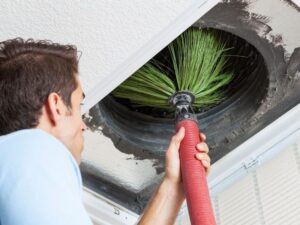Our immune and respiratory systems deteriorate with age, making us more vulnerable to allergens and toxins in the air. Health disorders like asthma, allergies and chronic obstructive lung disease can all worsen by poor IAQ. Here are seven tips for improving IAQ for elderly family members in Harlem, GA.
1. Use Air Purifiers
Air purifiers can remove pollutants and allergens from the air. Look for models with HEPA filters that collect tiny particles like pet hair, pollen and dust mites. An air purification system can be added to your existing HVAC system to ensure that your whole house has purified air.
Modern air conditioners have built-in air purifiers that may clean the air of harmful contaminants. These air purifiers eliminate airborne contaminants like germs, viruses, and volatile organic compounds using filters and additional technologies like UV-C lights.
2. Ventilate Properly
For excellent IAQ, proper ventilation is necessary. To remove moisture and odors, use exhaust fans in the kitchen and bathroom. As the weather permits, open the windows and doors to let fresh air in.
3. Keep the House Clean
To maintain optimal IAQ, regular cleaning is necessary. Carpets, upholstered furniture, and beds can gather dust, pet dander, and other allergens. Regularly dust, vacuum, and wash the curtains and bedding.
4. Avoid Smoking
A significant contributor to indoor air pollution is smoking. Family members who are older can develop respiratory issues even from secondhand smoke. Consider quitting or smoking outside if you or someone else in your home smokes.
5. Monitor Air Quality
You can track your house’s IAQ levels with air quality monitors. Some models can detect contaminants like carbon monoxide and volatile organic compounds. Regularly check the monitor, and if the levels are high, take appropriate action.
6. Control Humidity
Low indoor air quality can aggravate respiratory issues brought on by high humidity levels. Use a dehumidifier to keep humidity levels between 30% and 50%. A humidifier can assist in preventing respiratory discomfort and dry skin.
7. Choose Low-Emission Products
Many common household items, including paints, air fresheners and cleaning goods, include chemicals that can deteriorate indoor air quality. Choose items with low volatile organic compound emissions or all-natural substitutes like vinegar and baking soda.
It’s crucial to take care of any IAQ issues in your house and follow these recommendations. Here are a few typical IAQ problems and solutions.
It is possible for radon, a naturally occurring gas, to enter homes through the soil. That is one of the reasons non-smokers develop lung cancer. Get your house tested for radon, and if levels are excessive, install a mitigation system.
Up to the 1970s, asbestos was frequently found in building supplies. Mesothelioma and lung cancer can both develop through asbestos exposure. If you think your home might contain asbestos, have it professionally analyzed and, if necessary, removed.
Carbon monoxide is a lethal gas with no color or smell. Put carbon monoxide detectors in your home on every level, and schedule regular inspections of your heating and cooling systems.
An experienced HVAC company has the skills and knowledge to assess your home’s air quality and recommend improving it. They can run tests to find probable sources of pollution and gauge the level of contaminants in the air within your home. They have specialized products that can filter and clean your indoor air.
For your HVAC system to operate correctly and prevent contributing to bad IAQ, regular maintenance is crucial. An HVAC company can handle normal maintenance jobs like coil cleaning, filter changes and leak checks. The accumulation of dirt, dust and other impurities in your air ducts over time can decrease the efficiency of your HVAC system and worsen indoor air quality.
Working with a qualified HVAC company can help ensure good IAQ in your home, leading to better health and a higher quality of life. We at Doc Savage Heating & Air Conditioning Inc. will help with repairing and replacing your cooling system. Call us today to learn more.
Image provided by iStock



